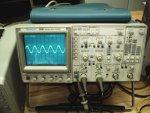Here's a layperson understanding: take a LF square wave, say 100Hz. Add a lowpass filter at 200Hz, nothing too steep, say 18dB/octave. What does the resulting wave look like on a scope? Where did the new wave come from? Was it fabricated?
Of course not, we know the square wave had a (theoretical infinite, practically much less so) series of odd-order overtones; the original square wave was actually the sum of very many sine waves (as all signals are). When we remove most of those overtones with a filter, we get a wave that looks pretty much like the fundamental sine wave which was there all along, hiding.
If a DAC actually worked like the staircase picture of a DAW, then it would output the original signal together with lot of ultrasonic overtones that were not part of the original signal. It has a reconstruction filter so that doesn't happen, instead it outputs an excellent approximation of the (bandwidth-limited) original signal . . . better than any other storage medium we have.
The only issue is how much bandwidth do we need? There are no practical compromises up to 40kHz bandwidth, up to 100kHz is debatable, beyond that we probably start to lose signal accuracy. Nobody has ever demonstrated a need for audio bandwidth greater than 40kHz though.







